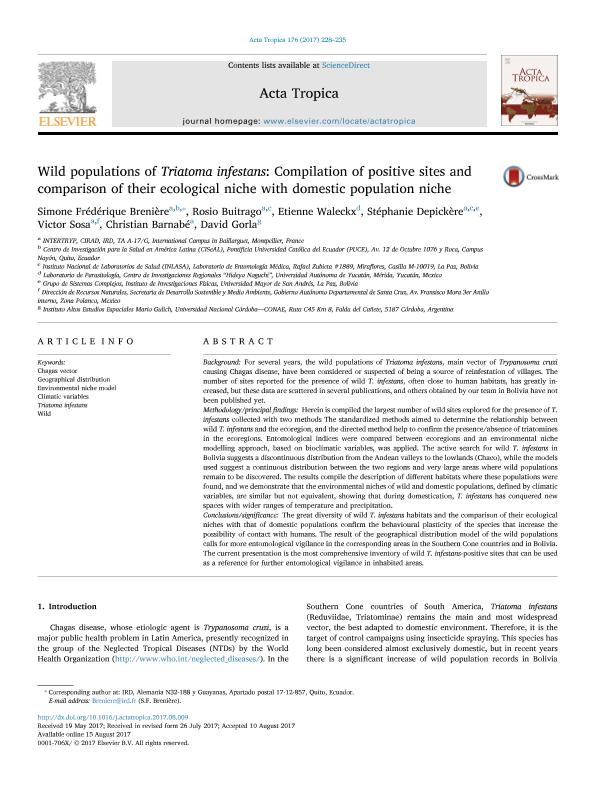Artículo
Wild populations of Triatoma infestans: Compilation of positive sites and comparison of their ecological niche with domestic population niche
Brenière, Simone Frédérique; Buitrago, Rosio; Waleckx, Etienne; Depickère, Stéphanie; Sosa, Victor; Barnabé, Christian; Gorla, David Eladio

Fecha de publicación:
12/2017
Editorial:
Elsevier Science
Revista:
Acta Tropica
ISSN:
0001-706X
Idioma:
Inglés
Tipo de recurso:
Artículo publicado
Clasificación temática:
Resumen
Background: For several years, the wild populations of Triatoma infestans, main vector of Trypanosoma cruzi causing Chagas disease, have been considered or suspected of being a source of reinfestation of villages. The number of sites reported for the presence of wild T. infestans, often close to human habitats, has greatly increased, but these data are scattered in several publications, and others obtained by our team in Bolivia have not been published yet. Methodology/principal findings: Herein is compiled the largest number of wild sites explored for the presence of T. infestans collected with two methods The standardized methods aimed to determine the relationship between wild T. infestans and the ecoregion, and the directed method help to confirm the presence/absence of triatomines in the ecoregions. Entomological indices were compared between ecoregions and an environmental niche modelling approach, based on bioclimatic variables, was applied. The active search for wild T. infestans in Bolivia suggests a discontinuous distribution from the Andean valleys to the lowlands (Chaco), while the models used suggest a continuous distribution between the two regions and very large areas where wild populations remain to be discovered. The results compile the description of different habitats where these populations were found, and we demonstrate that the environmental niches of wild and domestic populations, defined by climatic variables, are similar but not equivalent, showing that during domestication, T. infestans has conquered new spaces with wider ranges of temperature and precipitation. Conclusions/significance: The great diversity of wild T. infestans habitats and the comparison of their ecological niches with that of domestic populations confirm the behavioural plasticity of the species that increase the possibility of contact with humans. The result of the geographical distribution model of the wild populations calls for more entomological vigilance in the corresponding areas in the Southern Cone countries and in Bolivia. The current presentation is the most comprehensive inventory of wild T. infestans-positive sites that can be used as a reference for further entomological vigilance in inhabited areas.
Archivos asociados
Licencia
Identificadores
Colecciones
Articulos(SEDE CENTRAL)
Articulos de SEDE CENTRAL
Articulos de SEDE CENTRAL
Citación
Brenière, Simone Frédérique; Buitrago, Rosio; Waleckx, Etienne; Depickère, Stéphanie; Sosa, Victor; et al.; Wild populations of Triatoma infestans: Compilation of positive sites and comparison of their ecological niche with domestic population niche; Elsevier Science; Acta Tropica; 176; 12-2017; 228-235
Compartir
Altmétricas



